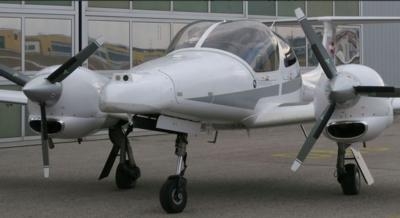Thu, Nov 17, 2016
System Should Improve Safety For Both Manned And Unmanned Flights
In close cooperation, experts of the AIT Austrian Institute of Technology and Diamond Aircraft Industries GmbH, have developed an intelligent sensor system enabling aircraft to detect and avoid potential obstacles both in the air and on the ground. This innovative airborne assistance system is an important step towards improving the safety of manned and unmanned flight.

Collision avoidance systems are a key technology for future unmanned aerial systems and advanced air traffic services. The objective is to increase the safety of manned and future unmanned aviation by detecting possible collisions with both cooperative and non-cooperative obstacles, and performing avoidance maneuvers as a last resort to avoid collisions. Obstacle avoidance is the key technology in missions involving the highest possible degree of autonomy, e.g. for generating situation maps for crisis and disaster management.
Experts at AIT have taken an innovative vision-based approach, enabling future unmanned aerial systems to observe and understand their environment in real-time. This approach goes beyond the state-of-the-art, making use of novel sensing techniques and route planning strategies for collision avoidance. The technology is capable of detecting both cooperative and non-cooperative objects in the airspace by fusing passive electro-optical and thermal-infrared sensor data. The technology was integrated in a Diamond Aircraft DA42 MPP and demonstrated in relevant scenarios.

Diamond Aircraft has used the test results to assess potential applications for this technology as an innovative and effective safety-improving feature both for unmanned flying objects and manned aviation. One option would be to integrate the technology into an autonomous flight control system similar to the one developed during a recent Diamond Aircraft project which, in 2015, successfully demonstrated safe autonomous flying for manned aircraft in emergency situations, including completely automated landing. Another possible use could be sensorial integration into conventional manned aircraft, to increase situational awareness and prevent collisions with airborne or ground obstacles. This would offer an additional and more reliable pair of artificial “eyes” able to generate potentially life-saving collision avoidance advisories.
(Images provided with Diamond Aircraft news release)
More News
Circle To Runway (Runway Number) Used by ATC to inform the pilot that he/she must circle to land because the runway in use is other than the runway aligned with the instrument appr>[...]
Aero Linx: National Aviation Safety Foundation (NASF) The National Aviation Safety Foundation is a support group whose objective is to enhance aviation safety through educational p>[...]
At Altitude Of About 250-300 Ft Agl, The Airplane Experienced A Total Loss Of Engine Power On November 6, 2024, at 1600 central standard time, a De Havilland DHC-1, N420TD, was inv>[...]
From 2009 (YouTube Edition): Three Hour Flight Was 'Flawless' -- At Least, Until Mother Nature Intervened For anyone who loves the aviation business, this was a VERY good day. Afte>[...]
Also: AMA Names Tyler Dobbs, More Falcon 9 Ops, Firefly Launch Unsuccessful, Autonomous F-16s The Air Force has begun ground testing a future uncrewed jet design in a milestone tow>[...]
 ANN's Daily Aero-Term (05.05.25): Circle To Runway (Runway Number)
ANN's Daily Aero-Term (05.05.25): Circle To Runway (Runway Number) ANN's Daily Aero-Linx (05.05.25)
ANN's Daily Aero-Linx (05.05.25) NTSB Prelim: De Havilland DHC-1
NTSB Prelim: De Havilland DHC-1 Classic Aero-TV: The Boeing Dreamliner -- Historic First Flight Coverage
Classic Aero-TV: The Boeing Dreamliner -- Historic First Flight Coverage Airborne-NextGen 05.06.25: AF Uncrewed Fighters, Drones v Planes, Joby Crew Test
Airborne-NextGen 05.06.25: AF Uncrewed Fighters, Drones v Planes, Joby Crew Test




